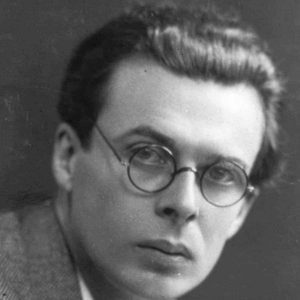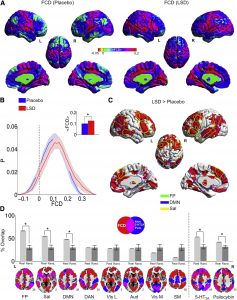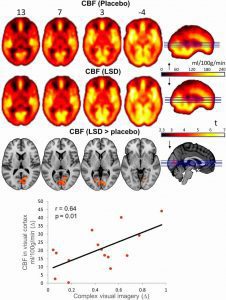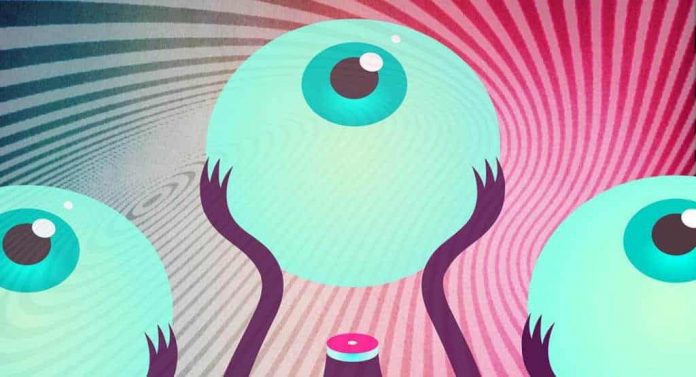Explaining what it’s like to trip on psychedelics is difficult to explain to someone who’s never tried them. And while LSD, mushrooms, DMT, ayahuasca, and MDMA elicit different effects, they’re all responsible for producing (often vivid) hallucinations in the people who take them.
How do psychedelics work, though? What’s happening in the brain that makes a person experience reality on a totally different plane? What do psychedelics do to bend the mind to perceive things in a way that’s impossible without them?
How Do Psychedelics Work in the Brain?
It’s widely accepted that psychedelics have a powerful effect on neural activity. Brain imaging scans have shown certain parts of the brain light up when under the influence of psychedelics, connecting different networks in the mind that typically don’t dance in psychedelic symmetry.
While the nature of exactly how psychedelics work in the brain isn’t completely understood, it’s believed they work in the cortex, where they’re known to activate serotonin receptors. One of these is known as 5-HT2A. It’s this 2A subtype of serotonin that’s believed to alter perception, however its not fully understood how exactly the effects psychedelics have on 5-HT2A produce hallucinations within the mind.
Neuroscientist Stuart Sealfon of Mount Sinai School of Medicine in New York speculates, “In order to function [the cortex is] integrating different signals, for example glutamate and serotonin signals, and what hallucinogens must be doing is they are disrupting the process so that the sensory perception is altered by them.”
Hallucinogens Hinder the Restriction of Conscious Awareness Said Aldous Huxley

In 1954, Aldous Huxley, philosopher and author of The Doors of Perception and Brave New World, proposed that the brain works as a “reducing valve” that constricts conscious awareness. He speculated that hallucinogens inhibit this filter and thus produce psychedelic effects. This was long before the psychedelic revolution of the 60s and 70s, as well as any real modern science of the mind had been conducted.
A study conducted almost 60 years later showed that Huxley was most likely right. In the study, functional magnetic resonance imaging (fMRI) was used to study the effects of psilocybin on 30 people who had previous experience using hallucinogens. The 2mg of psilocybin patients were given intravenously produced relatively intense psychedelic effects that were accompanied by reduced neuron activity in the prefrontal cortex and anterior cingulate cortex.
These two parts of the brain are connected to other parts of the brain that have to do with functions like introspection, cognitive processing, and emotional regulation. Restricted consciousness is basically obstructed under the influence of psychedelics, much like Huxley described hallucinogens to inhibit the filter of the conscious mind.
In other words, psychedelics work by opening the mind to what’s beyond the waking conscious realm.
A Brief Look into the Mind on LSD

One researcher in a 2016 study on LSD described, “You don’t recognize yourself as a separate being from the universe. It feels, in a way, like transferring the consciousness from within your own body to the outside world; the focus is in the objects that surround you rather than outside.”
One thing researchers noticed in this study was the regions in the brain involving introspection (thinking about one’s self) and the way one perceives the outside world communicated much more intensely under the influence of LSD.
“When we measured the brains of subjects who were really blown away by LSD, who had a really strong feeling of ego dissolution, they were also the ones who had the strongest increase in communication between the network regions in charge of introspection and the network regions in charge of perceiving the external world,” researchers noted.

Another study conducted by many of the same researchers the same year found that LSD alters visual information in the brain. When on LSD, people begin to perceive activity going on in the brain, which is typically suppressed. This is much in line with Huxley’s idea that psychedelics allow for what is usually constricted in the mind to surface under the influence of psychedelics.
The Mysteries of the Psychedelic Mind
Psychedelics have been used for centuries all over the world and are as much a mystery as the mind itself. How psychedelics work is a question that has been asked by countless people who have experienced the mysteries these substances contain.
There is a definite correlation between psychedelics and neural activity that seems to lie dormant without them. Can these realms of consciousness be touched without psychedelics? Or are these parts of ourselves subject to the psychedelic experience? Perhaps with more research, the mysteries will one day be revealed.
